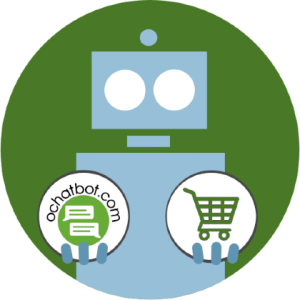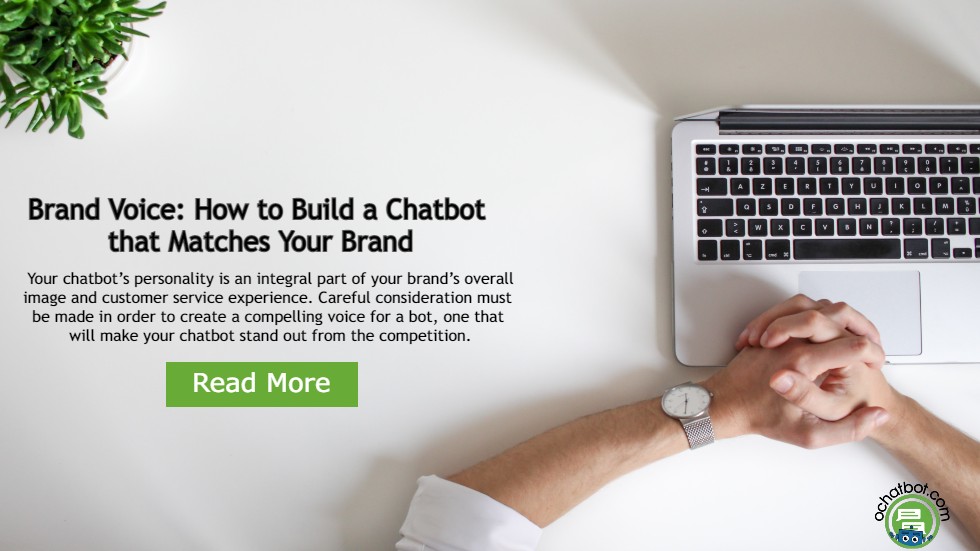Designing the way your chatbot interacts with customers carefully will help it develop a charming, consistent personality.
What is an AI Chatbot?
An Artificial Intelligence (AI) chatbot is a software program trained to have life-like conversations with users through the use of natural language processing (NLP). Unlike rule-based chatbots, which can only follow automated scripts and are unable to deviate from a pre-programmed response, AI chatbots learn to mimic human conversation by gathering and interpreting large amounts of data, allowing them to provide customers with natural conversations.
Why Add an AI Chatbot to Your Website?
By 2024, retail consumer spending will reach $140 billion through chatbots–a large increase from $2.8 billion in 2019, according to Insider Intelligence. By utilizing an AI chatbot for your business, you will be able to rapidly increase effective communication with customers. This leads to better customer satisfaction, which eventually leads to increased revenue.
AI chatbots provide 24/7 coverage for your business. A chatbot continues to answer questions during off-hours, making customers feel more valued by a brand when their issues are resolved quickly. Rather than waiting around for hours for the support team to respond, customer questions are quickly answered, overcoming sales obstacles that have stalled a customer at checkout.
Chatbots can also act as your brand’s sales associate through product suggestions and recommendations, building their basket and increasing sales. An example of good upselling and cross-selling through a bot is Ochatbot, which helps customers add the product right to their cart from the chatbot window.
Lastly, chatbots are a cost-saving measure. A support team paired with a well-developed chatbot is a dream team for any business. A customer service queue is often filled with many repetitive questions; these queues are long and can be frustrating for both the customer on hold and the human agents. Chatbots are able to quickly and efficiently answer these repetitive questions. Shortening the number of repetitive tickets a support team has to answer will reduce overhead costs and improve productivity.
Why Does a Chatbot Need a Voice?
An AI chatbot is essentially your brand’s 24/7 sales associate. It will often be the first thing customers encounter before they reach a human sales representative; therefore, a chatbot needs to match the tone you want customers to associate with your brand.
Giving a chatbot a voice helps avoid the robotic coldness that is sometimes associated with chatbots. It also makes your brand more memorable and sets you apart from competitors.
For example, Hector is the bot used by Ometrics, a company specializing in conversion rate optimization tools, but Hector also loves to tell jokes, share recipes, and offers peaceful life proverbs.

What is a Chatbot’s Personality?
A chatbot’s personality is built by carefully determining how the chatbot will interact with customers. The chatbot should maintain a consistent tone of voice with correct verbiage that aligns with the core of your brand. This is where you will want to partner with your brand’s marketing team. Ideally, the language you put forth through your business’ website should be reflected in the chatbot.
Understanding your consumer base will also determine a bot’s personality. A cryptocurrency brand with a demographic of 40-50-year-old men might not want a chatbot loaded with gen-z slang. Conversely, a hip clothing brand aimed at today’s teenagers might opt for a more friendly bot that behaves like a best friend.
This is not to say that an idiosyncratic chatbot could hurt your brand. On the contrary, humorous chatbots offer the highest potential for marketing virality. The mattress startup, Casper, and their insomnobot-3000 went viral in 2016 for that very reason. The bot is a self-described, “friendly, easily distracted bot designed to keep you company when you just can’t fall asleep.” This chatty bot will stay up with you all night, talking about exes, pizza, and Stranger Things. Creating a bot that will keep people coming back for more strengthens the familiarity of your brand name amongst the general public.
The Importance of Words
How your bot speaks is just as important as what it says. Consider these three greeting messages:
-
-
- Hi! I’m Nina, Brand’s Assistant. Is there anything I can help you with?
- Hello, my name is Nina, Brand’s AI chatbot. How may I be of assistance?
- Hey, my name’s Nina and I’m the bot that runs things around here. Let me know if there’s anything you need.
-
Each greeting serves the same purpose: to welcome customers to the website and offer help. However, what is conveyed are three entirely different images. The first response is casual but professional. The use of “hi” humanizes it. The second greeting is overly formal and also alerts the customer that they’re speaking with a chatbot right off the bat. While this response might seem robotic and cold, it also serves to temper expectations early with the bot. The last greeting does the same as the second in that it reveals its presence as a bot, but it does it in a completely humorous way.

Generative and Scripted AI to engage shoppers in conversational eCommerce.
Create happy customers while growing your business!
-
1 out of 4 shoppers make a purchase on average*
-
5% to 35% Increase in AOV*
-
25% to 45% Reduction in Support Tickets
WE GUARANTEE RESULTS!
Don’t Forget the Functionality
While a chatty robot companion can be entertaining to some, other customers might want information delivered quickly and efficiently. A scatterbrained chatbot that responds in gifs and emojis can quickly become irritating when it stops one from gathering information, leading to a lost sale.
If the purpose of your chatbot is to guide people through your website and complete sales, creating a useful shopping assistant will ultimately be the most important feature of the bot. A fully functional chatbot is just as memorable an experience as a wisecracking one.
How Does the Bot Handle Fallbacks?
A fallback is a message that appears when someone types something that a chatbot is not programmed to respond to. It is essentially ‘plan b’ for errors. How your bot handles fallbacks is especially important when dealing with frustrated customers. A canned response can make a customer feel unappreciated, and responding with humor can feel too flippant.
When handling errors, it’s best to err on the side of caution and maintain a professional tone. Directing the human to live chat to speak to a human agent is a great option. If live chat is not available, directing customers to another method of contact, like email, phone, or a contact form is another way of making customers feel like their complaints are being heard.
Male, Female, or Genderless?
Gender can be an important part of building a life-like chatbot’s personality. Making a chatbot male or female makes it more relatable for humans and can foster a welcoming environment on a site. For example, a pastry brand with a chatbot named Gertrude might invoke a feeling of grandmotherly love in their customers.
Although it would be obvious to assume the gender of a site’s chatbot mimics the brand’s demographic, the opposite is true in reality. According to research, most AI assistants are overwhelmingly female, whether that’s through their name, avatar, or mannerisms. For whatever reason, people all over the world have a preference for feminine assistants. One only has to think of the popularity of Siri, Alexa, and Google Assistant to understand how ubiquitous female artificial intelligence has become in our modern life. But as the research article linked above states, there are consequences to making women, “the face and voice of servility and dumb mistakes.”
Whether intentional or not, this has the potential to harm our relationship with gender. The popularity of feminine digital assistants further propagates the idea of the submissive woman in a service role.
So how can a business navigate this marketing nightmare while still creating a life-like chatbot? By removing traditional gender characteristics and opting for neutrality. Building a chatbot with a gender-neutral name and demeanor allows customers to focus on the matter at hand, engaging with your brand or products. This eliminates the potential for inappropriate conversations and removes the negative association between women and servility.
Bottom Line
Your chatbot’s personality is an integral part of your brand’s overall image and customer service experience. Bots can make an amazing positive first impression and strengthen the relationship between customers and your brand. However, there are no shortcuts when it comes to building a chatbot. Careful consideration must be made in order to create a compelling voice for a bot, one that will make your chatbot stand out from the competition.
Frequently Asked Questions
1. Do customers prefer chatbots?
In 2022, 62% of customers would rather use a chatbot than wait for a customer service agent to answer their query. The expectation of good customer service continues to evolve, and today’s younger shoppers are no longer willing to wait for information. They tend to shy away from talking to people or with a customer service representative and are concerned with being “sold too”. The round-the-clock support offered by chatbots is critical in engaging and retaining hard-earned online shoppers.
2. Are gender-neutral chatbots the best for every business?
This ultimately depends on your brand’s voice and messaging. While some researchers urge businesses to move away from gendered bots, one cannot deny the popularity and approachability of female chatbots.
3. What is the most price-conscious chatbot for eCommerce?
Ometrics’ Ochatbot is an easy-to-use, no-code AI-chatbot with strong conversational skills and powerful analytics. Cost-efficient plans like basic, plus, and pro are highly beneficial to eCommerce businesses.
- From Search to Checkout: AI’s Complete Takeover of E-commerce - December 1, 2023
- What is Headless Commerce and What are its Benefits? - October 9, 2023
- 10 Tips on Content Marketing Which Will Boost Sales on Shopify Stores - November 22, 2022


